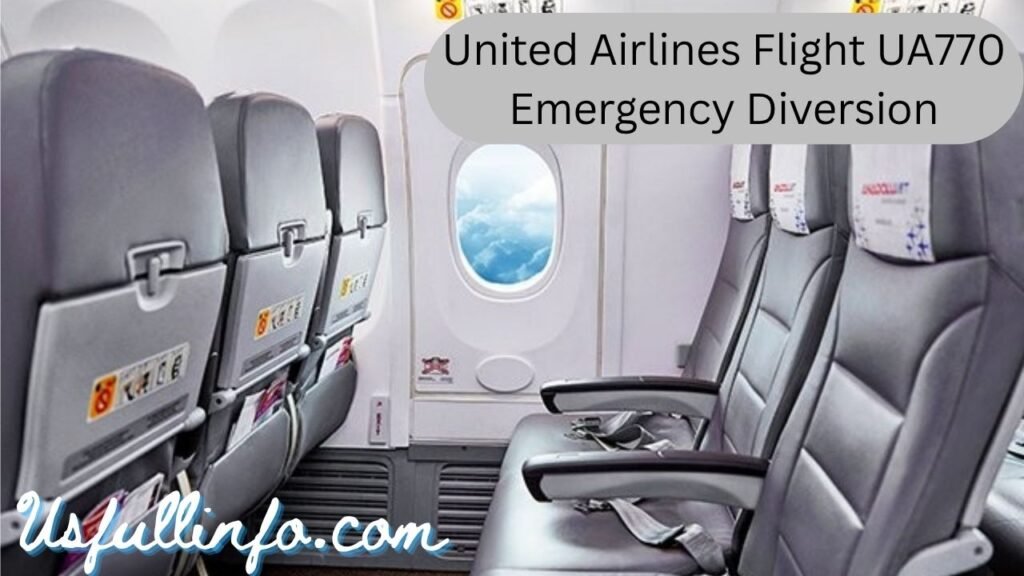The United Airlines Flight UA770 emergency diversion stands out as one of the more dramatic incidents in recent commercial aviation, drawing strong public and media attention. It was not an ordinary delay or route change but a fully declared emergency that required the crew to divert mid-flight, invoking standard and extreme safety protocols. In this article, we’ll walk you through the full narrative of what triggered the diversion, how it unfolded, what passengers experienced, and what lessons aviation stakeholders can draw for future safety.
To understand the full picture of the United Airlines Flight UA770 emergency diversion, it’s vital to view it not only as a one-time event but as a case study in how layered safety systems, crew training, and decision-making converge high above the ground.
Flight UA770: Basic Facts and Operational Context
United Airlines Flight UA770 was operating on a transatlantic route when the emergency occurred. According to multiple reports, the flight was scheduled between Barcelona (or another European origin) and Chicago (O’Hare), using a Boeing 787-9 Dreamliner.
On board were approximately 250+ passengers and a full crew complement. The aircraft had already reached cruising altitude when warning systems began signaling the anomaly that ultimately led to the United Airlines Flight UA770 emergency diversion.
Timeline of Events During the United Airlines Flight UA770 Emergency Diversion

The events of the United Airlines Flight UA770 emergency diversion unfolded rapidly once the crew detected the initial warning. The sequence, reconstructed from official and media sources, is as follows:
- Shortly after achieving cruising altitude, the aircraft’s pressurization or environmental control systems flagged an anomaly.
- The cockpit crew responded by declaring an emergency, selecting the Squawk 7700 code, which is the universal transponder code for in-flight emergencies.
- A controlled descent began, reducing altitude to a safer pressure environment.
- The flight diverted to London Heathrow Airport (LHR) in many accounts, though some early reports also mention Shannon, Ireland as a potential diversion point.
- The aircraft safely landed, the passengers and crew disembarked without reported injuries, and the airplane was held for inspection and maintenance.
This timeline underscores how rapidly decisions must be made under pressure during such emergencies.
What Triggered the Diversion? Possible Causes of the United Airlines Flight UA770 Emergency Diversion
Root cause analysis for in-flight diversions is always complex, and in the case of the United Airlines Flight UA770 emergency diversion, the following possibilities are considered most likely:
- Cabin Pressurization Warning / Environmental Control Issue
Many sources point to a pressurization alarm or fault in the environmental control system as the initial trigger. The system that maintains cabin pressure at altitude may have malfunctioned or detected sensor anomalies. - Backup System or Sensor Failure
In modern aircraft, redundancy is essential. If the backup pressurization system or sensor suite failed or failed to respond, the crew would have had to treat the warning as credible. - Medical Emergency Onboard (Less Likely in This Case)
While medical emergencies are a common reason for diversions, the reports around UA770 emphasize system warnings more than health issues. Still, in-flight health issues cannot be ruled out in general diversion incidents. - Other System or Electrical Faults
Secondary faults in pneumatic systems, bleed air, or electrical control lines could precipitate or complicate pressurization issues. Though less directly reported, they form part of the investigative scope.
At this juncture, the most widely accepted hypothesis is that a pressurization system alert, recognized as credible by the flight crew, forced the diversion decision.
Decision & Protocol: How the Crew Initiated the United Airlines Flight UA770 Emergency Diversion
Once the warning was flagged, the crew followed established safety procedures. Their decision-making and execution are exemplary of how aviation systems are designed to handle disaster scenarios:
The cockpit crew first confirmed the fault via redundant instrument checks and communications between pilots. They consulted with airline operations and coordinated with air traffic control to declare a formal emergency (Squawk 7700) to clear airspace priority. Simultaneously, they briefed the cabin crew to prepare passengers for potential descent and landing.
Inside the cabin, the flight attendants relayed calm but firm instructions, ensuring passengers remained buckled, distributing oxygen if necessary, and guiding preparation for a possible landing sequence. Clear communication and orderliness are essential to prevent panic during such high-stress moments.
Coordination with ground controllers and emergency services at the diversion airport also takes place before landing, so that rescue and medical support are ready on the runway as the aircraft arrives.
Passenger Experience During the United Airlines Flight UA770 Emergency Diversion
For the passengers aboard the flight, the emotional and sensory experience was undoubtedly intense. Initially, many likely felt confusion or alarm at subtle air-frame behavior or cockpit announcements. As the situation evolved, oxygen masks may have dropped or cabin announcements clarified the seriousness.
Throughout, many passengers later reported being impressed by the calm demeanor of the crew. Some said the captain and cabin crew repeatedly reassured them and provided updates as best as possible under the circumstances. The descent, though rapid, was reportedly managed smoothly, and the landing was executed without further complication.
After landing, passengers experienced the logistical fallout: rebooking, hotel stays (if required), retrieval of luggage, and waiting until onward flights could continue. In many diversion incidents, airlines prioritize care, but the stress and disruption remain substantial for travelers.
Airport & Ground Handling in Response to the United Airlines Flight UA770 Emergency Diversion
When a diverted aircraft is incoming, the chosen airport must mobilize emergency responders, fire & rescue services, medical teams, and ground handling staff to assist immediately upon landing. In the case of United Airlines Flight UA770, ground teams were reportedly on standby.
Runway clearance, priority landing slots, taxi routing, and gate availability are all coordinated well in advance to reduce delays and risk. Post-landing, the crew, ground staff, and maintenance engineers collaborate to assess the aircraft, support passengers, and initiate the investigation.
Official Statements & Transparency Around the United Airlines Flight UA770 Emergency Diversion
In the aftermath of the emergency, United Airlines issued statements confirming that Flight UA770 made an emergency diversion, citing safety protocols being activated and that no injuries were reported.
Further updates suggested that the Boeing 787-9 involved was undergoing inspection for pressurization / environmental control systems before being cleared to return to service.
While such official releases aim to reassure the public, full technical details often await deeper analysis by regulatory bodies and internal investigations.
Technical & Safety Review Post-Diversion
After any declared emergency, regulators (e.g., FAA, EASA, national civil aviation authorities) launch investigations that examine flight data recorders, cockpit voice recorders, maintenance logs, sensor outputs, and crew actions.
The aircraft involved in the United Airlines Flight UA770 emergency diversion is typically grounded until engineers validate the integrity of systems, especially those related to pressurization, airframe, and environmental control. Any identified anomalies may lead to part replacements or system upgrades. Lessons from the incident may feed into operational protocols, training modules, and fleet safety audits.
Media Coverage, Public Reaction & Social Media Around the United Airlines Flight UA770 Emergency Diversion
News outlets, travel blogs, and social platforms rapidly picked up the story of the United Airlines Flight UA770 emergency diversion, highlighting passenger testimonies, dramatic visuals, and safety commentary. Tweets, posts, and hashtags amplified speculation and analysis in real time.
Many commenters praised the professionalism and calm of the crew, while some expressed fear or criticism of airline transparency. Aviation enthusiasts dissected flight tracker data and logged the squawk code activation. The combination of social media immediacy and traditional journalism created a comprehensive narrative that still evolves as more official detail emerges.
Comparative Context: Other Notable Airline Diversions
To place the United Airlines Flight UA770 emergency diversion in context, one can compare to other high-profile diversions:
- United Flight 328 (2021): Engine failure over Denver forced an emergency landing; debris fell in nearby residential areas but no serious injuries occurred.
- Other pressurization or cabin-altitude incidents: On occasion, minor pressure warnings have led to precautionary diversions even when the fault turned out to be sensor glitches.
These comparisons highlight that while diversions are uncommon, they are a practiced contingency in modern aviation safety.
Lessons Learned From the United Airlines Flight UA770 Emergency Diversion
The UA770 diversion underscores several critical lessons:
First, training and adherence to procedure remain paramount. Even with modern autopilot and monitoring systems, the human element (pilots, cabin crew) must respond decisively under pressure.
Second, redundancy in systems, sensors, and backups is non-negotiable. The failure or misreading of one sensor or subsystem should not cascade into disaster.
Third, communication—both with passengers and ground control—must be clear, consistent, and timely to maintain order and trust.
Finally, every diversion event is an opportunity for iterative improvement: updating checklists, refining emergency drills, upgrading hardware, and sharing data across the aviation community.
The Role of AI, Predictive Monitoring & Future Safety in Avoiding Diversions
Looking forward, emerging technologies like AI-driven health-monitoring systems for aircraft, predictive maintenance analytics, and enhanced sensor cross-checking may reduce the likelihood of diversions. Automated systems could flag incipient faults before they escalate.
Real-time data sharing between aircraft, ground operations, and manufacturer servers can help anticipate system stress or anomalies. Training simulators may evolve to include even more varied failure scenarios, preparing crews for increasingly complex emergencies.
The United Airlines Flight UA770 emergency diversion may itself serve as input to future safety algorithms and design improvements in pressurization system resilience.
What Passengers Should Know When a Flight Diversion Happens
For travelers, there are some practical and psychological takeaways from the experience of United Airlines Flight UA770 emergency diversion:
- Remain calm and follow cabin crew instructions without delay.
- Understand that diversions, though disconcerting, are often precautionary measures for your safety.
- Save all receipts, boarding passes, and documentation in case airline compensation or rebooking is involved.
- Be mentally prepared for delays, reroutings, or overnight accommodations.
Knowing that airlines have protocols in place and that flight crews train for emergencies can ease anxiety when unexpected changes occur.

Aviation Policy & Regulatory Implications After the United Airlines Flight UA770 Emergency Diversion
Regulatory bodies often revisit certification standards, maintenance regimes, inspection intervals, and reporting requirements in light of incidents like UA770’s diversion.
Aviation authorities may mandate deeper inspections of environmental control systems across fleets, enforce stricter sensor calibration protocols, or require additional crew training. Airlines may adopt more aggressive predictive maintenance cycles. Public reporting requirements may increase transparency so that future diversions are better documented for analysis.
Broader Impact: Trust, Reputation & Airline Risk Management
An emergency diversion such as this can influence public perception of airline safety, particularly if communications are inconsistent or delayed. Airlines must manage their reputational risk by being transparent, responsive, and customer-oriented in the aftermath.
From a financial and operational standpoint, diversions incur costs: repositioning aircraft, crew logistics, passenger accommodations, and downtime. For major carriers like United, maintaining trust and minimizing disruption is a core risk management concern.
Summary & Concluding Thoughts on the United Airlines Flight UA770 Emergency Diversion
The United Airlines Flight UA770 emergency diversion is a powerful reminder that even routine flights can demand the best of human judgment, system integrity, and crisis readiness. Though diversion incidents remain rare in commercial aviation, each one is instructive.
In this case, the safety systems, pilot decisions, and ground coordination aligned to produce a successful outcome—no injuries, no casualties—even under urgent conditions. The event reinforces the core tenet of aviation: safety above all. For passengers, it illustrates that protocols exist not just on paper but in action, and that modern air travel — though complex — has multiple safeguards built in for the rare moments when things go awry.








